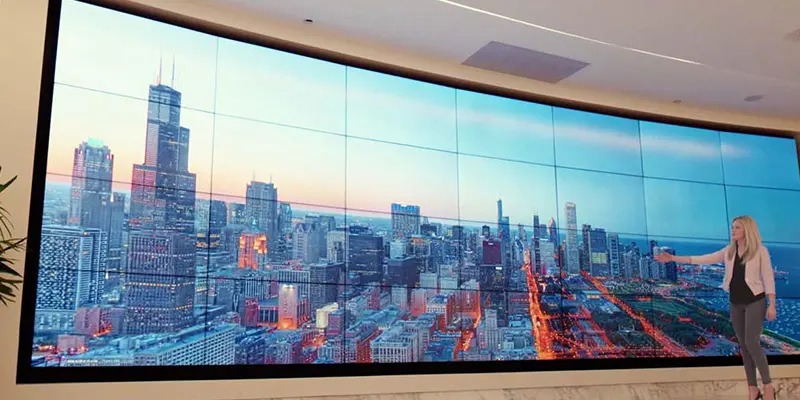What is an LCD Video Wall Screen?
1. What is LCD Technology?
LCD stands for Liquid Crystal Display. It uses liquid crystals that align in various ways when an electric current passes through them. These crystals don’t emit light by themselves; instead, they rely on backlighting—usually LED lights—to illuminate the display.
2. How LCD Technology Works
When voltage is applied, liquid crystals twist to block or allow light to pass through colored filters (red, green, blue). This combination creates millions of colors and crisp, bright visuals. The precision of this technology is what makes LCD screens ideal for video walls.
3. Structure of an LCD Video Wall
Each LCD video wall is composed of several individual display panels arranged in a grid. The bezel—the thin border around each screen—is designed to be as narrow as possible to minimize visible gaps between screens.
These panels are mounted using durable frames or brackets and controlled by a video wall processor, which synchronizes the images across all screens to ensure a seamless picture.
4. How an LCD Video Wall Works
The video wall connects to a content controller or media player, which splits and distributes the image across all panels. Advanced software ensures synchronization so every display shows the right portion of the image in real time.
Through a content management system (CMS), users can update, schedule, and manage what appears on the wall—from live feeds to marketing videos.
5. Key Components
LCD Panels: The main display units.
Video Wall Controller: Manages content distribution and synchronization.
Media Player: Supplies video or data streams.
Mounting Frame: Ensures secure installation and alignment.
6. Installation and Setup
Installing an LCD video wall requires careful planning. The process includes:
Assessing wall space, power, and cooling needs.
Mounting and aligning panels.
Connecting control hardware and software.
Calibrating brightness, color, and contrast for consistency.
Once set up, it delivers a stunning, unified visual presentation.
7. Advantages of Using LCD Video Walls
High Resolution: Perfect for close-up viewing.
Flexible Configurations: Can be scaled to any size or shape.
Energy Efficient: LCDs consume less power compared to projection systems.
Affordable: Generally cheaper than LED walls for indoor applications.
LCD video walls combine clarity, versatility, and cost-effectiveness—making them a smart choice for many businesses.
8. Maintenance and Lifespan
LCD video walls typically last 40,000–60,000 hours depending on use. Regular maintenance includes:
Dusting the screen surface.
Updating software.
Checking connections and power supplies.
With proper care, they can perform reliably for many years.
9. Choosing the Right LCD Video Wall
When choosing your setup, consider:
Screen Size & Resolution: Fit the viewing distance.
Brightness: Adjust for ambient lighting.
Budget & Maintenance Costs: Balance quality with long-term value.
10. Content Management for LCD Walls
Modern CMS tools let users:
Schedule content remotely.
Integrate live feeds or social media.
Control multiple walls across locations.
This gives you total flexibility in managing digital content effortlessly.
11. Future Trends in LCD Video Walls
The future looks bright for LCD technology:
Thinner Bezels and 4K/8K Resolutions for seamless displays.
AI-powered content systems that adapt visuals automatically.
Eco-friendly materials reducing energy use and waste.
12. Conclusion
An LCD video wall screen is more than just a display—it’s a communication powerhouse. With its sharp visuals, modular design, and affordability, it’s ideal for businesses aiming to captivate audiences or monitor critical data efficiently. As technology evolves, LCD video walls continue to redefine visual engagement across industries.
FAQs
1. What’s the difference between LCD and LED video walls?
LCD uses liquid crystal panels with backlighting, while LED walls use self-illuminating diodes. LCDs are better for indoor, close-up use.
2. How long do LCD video walls last?
Most LCD video walls last 5–7 years with proper maintenance.
3. Are LCD video walls energy efficient?
Yes, they consume less power than traditional projection or plasma displays.
4. Can LCD video walls be used outdoors?
Typically no; they’re designed for indoor environments due to brightness and weather factors.
5. What industries benefit most from LCD video walls?
Retail, transportation, education, and corporate sectors rely heavily on LCD walls for advertising and communication.


